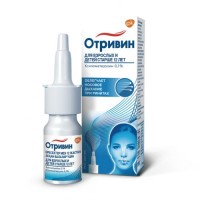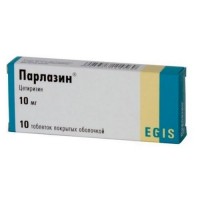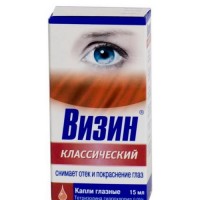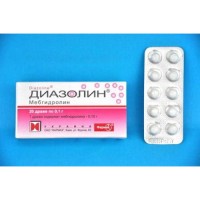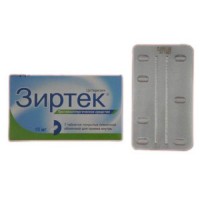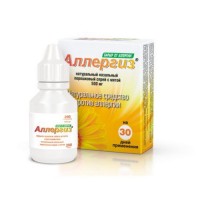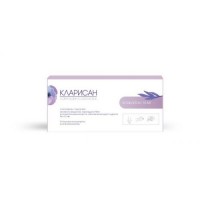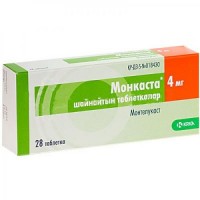Zodak 30s 10 mg coated tablets
- $19.80
The instruction for medical use of ZODAK® medicine the Trade name of Zodak® the International unlicensed name Tsetirizin Lekarstvennaya the Tablet form, coated, 10 mg Structure One tablet contains active agent – a tsetirizin dihydrochloride of 10 mg excipients: lactoses monohydrate, starch corn, povidone 30, magnesium stearate, cover: a gipromelloza 2910/5, a macrogoal 6000, talc, the titan dioxide (E171), an emulsion of a simetikon of SE 4 the Description of the Tablet, oblong shape, coated, white or almost white color, with risky for a break on one party Pharmacotherapeutic group the Respiratory system. Antihistaminic drugs of systemic action. Piperazin derivatives. Tsetirizin. The ATX R06AE07 code the Pharmacological Pharmacokinetics Stable Peak Concentration properties of a tsetirizin in blood plasma are about 300 ng/ml and are reached in 1.0 - 0.5 h. At reception of a tsetirizin within 10 days in a dose of 10 mg/day of accumulation it was not observed. Pharmacokinetic parameters of the maximum concentration in Cmax blood and the area under pharmacokinetic curve AUC and distribution have one peak. Meal does not influence extent of absorption, however absorption speed slightly decreases. Degree of bioavailability is similar when using a tsetirizin in the form of solution, capsules or tablets. The seeming volume of distribution is 0.50 l/kg. Linking of a tsetirizin with proteins of blood plasma 93 ± 0.3%. Tsetirizin does not influence linking of warfarin with proteins of plasma. Tsetirizin shows linear kinetics in the range of doses from 5 mg to 60 mg. Tsetirizin is not exposed to considerable metabolism at the first passing through a liver. Elimination half-life makes about 10 hours. About 2/3 doses are removed in an invariable form with urine. Special groups of patients Elderly: after single dose of 10 mg the elimination half-life increases approximately by 50%, and the clearance decreases by 40%. Decrease in clearance of a tsetirizin at elderly is possibly connected with decrease in function of kidneys at them. Children: elimination half-life of a tsetirizin makes about 6 hours at children at the age of 6-12 years. Patients with a renal failure: at patients to a slight renal failure (the clearance of creatinine (CC) & gt, 40 ml/min.) the pharmacokinetics of drug was similar to pharmacokinetics of healthy volunteers. In a moderate renal failure, in comparison with healthy volunteers, elimination half-life increases by 3 times, and the clearance went down for 70%. Tsetirizin is badly brought by means of a hemodialysis. Selection of a dose is necessary for patients with moderate and heavy degree of a renal failure. Patients with a liver failure: at patients with chronic diseases of a liver (pechenochnokletochny, cholestatic and biliary cirrhosis), the receiving 10-20 mg of a tsetirizin once, increase in elimination half-life of a tsetirizin for 50% was noted at simultaneous decrease in clearance by 40%. Selection of a dose is necessary for patients with a liver failure who have an accompanying renal failure. The pharmacodynamics the Drug Zodak®, Hydroxyzinum metabolite, is a selection antagonist of peripheral H1 - histamine receptors. The drug Zodak® showed antiallergic activity at reception of a dose of 10 mg at reception 1 or 2 times a day: drug inhibits migration of eosinophils in a late phase in skin and in mucous conjunctivas at the persons suffering from an atopy after provocative test with allergen. Accustoming cases to antihistaminic action of a tsetirizin during the 35th day course of treatment of children at the age of 5-12 years (suppression of blistering and reddening) were not revealed. Usual reaction of skin to a histamine was restored within 3 days after the termination of the course of treatment meaning repeated introduction of a tsetirizin. In the recommended dose the drug Zodak® showed improvement of quality of life at patients with year-round and seasonal allergic rhinitis. Indications Relief of symptoms of allergic diseases at adults and children are more senior than 6 years: - seasonal and year-round allergic rhinitis and conjunctivitis (pollinosis, hay fever) - a chronic idiopathic small tortoiseshell the Route of administration and doses Adults and teenagers are more senior than 12 years: 10 mg (1 tablet) once a day. Children at the age of 6 - 12 years: 5 mg (on ½ tablets) two times a day. Elderly patients: older persons have no need of a dose decline on condition of normal function of kidneys. Patients with a moderate or heavy renal failure: data on a ratio of efficiency/safety of drug for patients with disturbances of renal function are absent. In case of lack of alternative methods of treatment, it is necessary to change dosing intervals individually, depending on renal function (as the main way of removal of a tsetirizin are kidneys). In the table given below necessary changes of a dose are specified. To use this table, it is necessary to define KK in ml/min. The KK value (ml/min.) can be defined on the basis of creatinine of blood serum (mg/dl) by a formula:
x the weight (kg) of KK = — —— — ——— —— — —— — ——— ——— — (x 0.85 for women) 72 x creatinine of blood serum (mg/dl) of the Dose of the drug Zodak® for adult patients with disturbance of renal function: The KK group (ml/min.) the Dosage and frequency of use Normal function ≥ 80 10 mg once a day Easy insufficiency of 50-79 10 mg once a day the Moderated insufficiency of 30-49 5 mg once a day Heavy insufficiency & lt, to 30 5 mg is each 2 days the End-stage of a renal failure – patients on dialysis & lt, 10 Contraindicated At children with a renal failure the dose has to be selected on an individual basis taking into account renal clearance, age and body weight. Patients with a liver failure: from the dose isolated by a liver failure of selection it is not required from patients. Patients with a liver and renal failure: selection of a dose is recommended. The course of treatment is defined by the attending physician. Route of administration: tablets should be swallowed and washed down with a glass of water. Side effects the Provided side effects are divided on groups, according to terminology of MedDRA and frequency of emergence: very frequent (≥1/10), frequent (from ≥1/100 to & lt, 1/10), infrequent (from ≥1/1000 to & lt, 1/100), rare (from ≥1/10000 to & lt, 1/1000), extremely rare (& lt, 1/10000), unknown (it is impossible to estimate on the basis of available data): Very often: - dysuria, enuresis Infrequently: - excitement - paresthesia - diarrhea - an itching, rash - an asthenia, fatigue Seldom: - reactions of hypersensitivity - aggression, confusion of consciousness, a depression, hallucination, insomnia - spasms - tachycardia - deviations of indicators of function of a liver (the increased content of transaminase, alkaline phosphatase, gamma glutaminetransferase and bilirubin) - a small tortoiseshell - swelled - increase in weight is Very rare: - thrombocytopenia - an acute anaphylaxis - tics - disturbance of taste (dysgeusia), a faint, a tremor, dystonia, dyskinesia - disturbance of accommodation of a lens, the obscured sight, restriction of the movement of an eyeball - a Quincke's disease, a resistant medicinal erythema Frequency is unknown: - the increased appetite - suicide thoughts, nightmares - amnesia, memory disturbances - dizziness - sharp generalized ekzentematozny pustulez - an arthralgia - a delay of urination of the Contraindication - hypersensitivity to active agent or any of drug excipients, derivatives of Hydroxyzinum or piperazin - patients with a heavy renal failure (clearance of creatinine less than 10 ml/min.) - patients with inherited disorders (rare hereditary galactosemia, hereditary intolerance of Lapp-lactase or malabsorption of glucose galactose) - children's age up to 6 years - pregnancy and the period of a lactation Medicinal interactions Thanks to pharmacokinetic and pharmakodinamichesky properties of a tsetirizin and also thanks to its shipping, this antihistamine usually does not enter any interactions. Actually, neither pharmakodinamichesky, nor considerable pharmacokinetic interaction was reported in the conducted researches in interaction with medicines, in particular with pseudoephedrine or theophylline (400 mg/days). The general extent of absorption of a tsetirizin does not decrease with meal though absorption speed slightly decreases. Sensitive patients have an administration of drug along with the alcohol or other drugs suppressing activity of central nervous system can cause additional decrease in level of concentration and working capacity. Special instructions In therapeutic doses of clinically significant interactions with alcohol it is not shown (at alcohol level in blood of 0.5 g/l). Nevertheless, at a concomitant use of alcohol it is necessary to be careful. It is necessary to pay special attention to patients who are subject to influence of the factors contributing to an urination delay (for example, damages of a spinal cord, a prostate hyperplasia) as tsetirizin can increase risk of a delay of urination. It is recommended to pay special attention to patients with epilepsy or risk of developing of spasms. The tablet drug Zodak®, coated, are contraindicated to patients with a rare hereditary galactosemia, hereditary intolerance of Lapp-lactase or malabsorption of glucose and a galactose. Use in pediatrics the Administration of drug of Zodak® of tablets, coated, is not recommended to babies and children 6 years as this dosage form does not allow to modify a necessary dose are younger. During pregnancy or a lactation, Drug is contraindicated during pregnancy and a lactation. Fertility: data on fertility of the person are limited, but threats to security was not revealed. Features of influence of drug on ability to run the vehicle or potentially dangerous mechanisms At objective assessment of ability to driving of the car and work with potentially dangerous mechanisms any undesirable phenomena are authentically not revealed when assigning of the recommended dose of 10 mg. Nevertheless, it is reasonable to abstain from occupations potentially dangerous types of activity demanding the increased concentration of attention and speed of psychomotor reactions as some patients can test drowsiness, fatigue and an asthenia. Overdose Symptoms: are connected by the most part with influence on central nervous system or the effects assuming anticholinergic influence. The following symptoms of overdose after reception of a dose at least by 5 times exceeding the recommended daily were observed: confusion of consciousness, diarrhea, dizziness, fatigue, headache, feeling of alarm, expansion of pupils, naggers, feeling of concern, sedation, drowsiness, stupor, tachycardia, tremor and delay of urination. Treatment: Specific antidote is absent. The symptomatic or supporting treatment. With small duration after administration of drug it is necessary to wash out a stomach. The hemodialysis is not effective the Form of release and packing On 10 tablets in blister strip packaging from a film of PVH/PVDH and aluminum foil. On 1 or 3 blister strip packagings together with the instruction for medical use in the state and Russian languages place in a pack from cardboard. Storage conditions At a temperature not above 25 °C. To store out of children's reach! 3 years not to apply a period of storage after an expiration date. Prescription status According to the prescription the Producer / packer Zentiva to. page, Prague, the Czech Republic the Owner of the registration certificate of Sanofi-aventis Kazakhstan LLP, Almaty, Kazakhstan the Name, the address and a contact information (phone, the fax, e-mail) of the organization accepting in the territory of the Republic of Kazakhstan a claim (offer) on quality of medicines from consumers of Sanofi-aventis Kazakhstan LLP Republic of Kazakhstan, 050013, Almaty, N. Nazarbayeva Ave, 187B phone number: +7 (727) 244-50-96 fax: +7 (727) 258-25-96 e-mail: quality.info@sanofi.com the Name, the address and a contact information (phone, the fax, e-mail) of the organization in the territory of the Republic of Kazakhstan responsible for post-registration observation of safety of medicine of Sanofi-aventis Kazakhstan LLP Republic of Kazakhstan, 050013, Almaty, N. Nazarbayeva Ave, 187b phone number: +7 (727) 244-50-96 fax: +7 (727) 258-25-96 e-mail:
To Develop Kazakhstan.Pharmacovigilance@sanofi.com
x the weight (kg) of KK = — —— — ——— —— — —— — ——— ——— — (x 0.85 for women) 72 x creatinine of blood serum (mg/dl) of the Dose of the drug Zodak® for adult patients with disturbance of renal function: The KK group (ml/min.) the Dosage and frequency of use Normal function ≥ 80 10 mg once a day Easy insufficiency of 50-79 10 mg once a day the Moderated insufficiency of 30-49 5 mg once a day Heavy insufficiency & lt, to 30 5 mg is each 2 days the End-stage of a renal failure – patients on dialysis & lt, 10 Contraindicated At children with a renal failure the dose has to be selected on an individual basis taking into account renal clearance, age and body weight. Patients with a liver failure: from the dose isolated by a liver failure of selection it is not required from patients. Patients with a liver and renal failure: selection of a dose is recommended. The course of treatment is defined by the attending physician. Route of administration: tablets should be swallowed and washed down with a glass of water. Side effects the Provided side effects are divided on groups, according to terminology of MedDRA and frequency of emergence: very frequent (≥1/10), frequent (from ≥1/100 to & lt, 1/10), infrequent (from ≥1/1000 to & lt, 1/100), rare (from ≥1/10000 to & lt, 1/1000), extremely rare (& lt, 1/10000), unknown (it is impossible to estimate on the basis of available data): Very often: - dysuria, enuresis Infrequently: - excitement - paresthesia - diarrhea - an itching, rash - an asthenia, fatigue Seldom: - reactions of hypersensitivity - aggression, confusion of consciousness, a depression, hallucination, insomnia - spasms - tachycardia - deviations of indicators of function of a liver (the increased content of transaminase, alkaline phosphatase, gamma glutaminetransferase and bilirubin) - a small tortoiseshell - swelled - increase in weight is Very rare: - thrombocytopenia - an acute anaphylaxis - tics - disturbance of taste (dysgeusia), a faint, a tremor, dystonia, dyskinesia - disturbance of accommodation of a lens, the obscured sight, restriction of the movement of an eyeball - a Quincke's disease, a resistant medicinal erythema Frequency is unknown: - the increased appetite - suicide thoughts, nightmares - amnesia, memory disturbances - dizziness - sharp generalized ekzentematozny pustulez - an arthralgia - a delay of urination of the Contraindication - hypersensitivity to active agent or any of drug excipients, derivatives of Hydroxyzinum or piperazin - patients with a heavy renal failure (clearance of creatinine less than 10 ml/min.) - patients with inherited disorders (rare hereditary galactosemia, hereditary intolerance of Lapp-lactase or malabsorption of glucose galactose) - children's age up to 6 years - pregnancy and the period of a lactation Medicinal interactions Thanks to pharmacokinetic and pharmakodinamichesky properties of a tsetirizin and also thanks to its shipping, this antihistamine usually does not enter any interactions. Actually, neither pharmakodinamichesky, nor considerable pharmacokinetic interaction was reported in the conducted researches in interaction with medicines, in particular with pseudoephedrine or theophylline (400 mg/days). The general extent of absorption of a tsetirizin does not decrease with meal though absorption speed slightly decreases. Sensitive patients have an administration of drug along with the alcohol or other drugs suppressing activity of central nervous system can cause additional decrease in level of concentration and working capacity. Special instructions In therapeutic doses of clinically significant interactions with alcohol it is not shown (at alcohol level in blood of 0.5 g/l). Nevertheless, at a concomitant use of alcohol it is necessary to be careful. It is necessary to pay special attention to patients who are subject to influence of the factors contributing to an urination delay (for example, damages of a spinal cord, a prostate hyperplasia) as tsetirizin can increase risk of a delay of urination. It is recommended to pay special attention to patients with epilepsy or risk of developing of spasms. The tablet drug Zodak®, coated, are contraindicated to patients with a rare hereditary galactosemia, hereditary intolerance of Lapp-lactase or malabsorption of glucose and a galactose. Use in pediatrics the Administration of drug of Zodak® of tablets, coated, is not recommended to babies and children 6 years as this dosage form does not allow to modify a necessary dose are younger. During pregnancy or a lactation, Drug is contraindicated during pregnancy and a lactation. Fertility: data on fertility of the person are limited, but threats to security was not revealed. Features of influence of drug on ability to run the vehicle or potentially dangerous mechanisms At objective assessment of ability to driving of the car and work with potentially dangerous mechanisms any undesirable phenomena are authentically not revealed when assigning of the recommended dose of 10 mg. Nevertheless, it is reasonable to abstain from occupations potentially dangerous types of activity demanding the increased concentration of attention and speed of psychomotor reactions as some patients can test drowsiness, fatigue and an asthenia. Overdose Symptoms: are connected by the most part with influence on central nervous system or the effects assuming anticholinergic influence. The following symptoms of overdose after reception of a dose at least by 5 times exceeding the recommended daily were observed: confusion of consciousness, diarrhea, dizziness, fatigue, headache, feeling of alarm, expansion of pupils, naggers, feeling of concern, sedation, drowsiness, stupor, tachycardia, tremor and delay of urination. Treatment: Specific antidote is absent. The symptomatic or supporting treatment. With small duration after administration of drug it is necessary to wash out a stomach. The hemodialysis is not effective the Form of release and packing On 10 tablets in blister strip packaging from a film of PVH/PVDH and aluminum foil. On 1 or 3 blister strip packagings together with the instruction for medical use in the state and Russian languages place in a pack from cardboard. Storage conditions At a temperature not above 25 °C. To store out of children's reach! 3 years not to apply a period of storage after an expiration date. Prescription status According to the prescription the Producer / packer Zentiva to. page, Prague, the Czech Republic the Owner of the registration certificate of Sanofi-aventis Kazakhstan LLP, Almaty, Kazakhstan the Name, the address and a contact information (phone, the fax, e-mail) of the organization accepting in the territory of the Republic of Kazakhstan a claim (offer) on quality of medicines from consumers of Sanofi-aventis Kazakhstan LLP Republic of Kazakhstan, 050013, Almaty, N. Nazarbayeva Ave, 187B phone number: +7 (727) 244-50-96 fax: +7 (727) 258-25-96 e-mail: quality.info@sanofi.com the Name, the address and a contact information (phone, the fax, e-mail) of the organization in the territory of the Republic of Kazakhstan responsible for post-registration observation of safety of medicine of Sanofi-aventis Kazakhstan LLP Republic of Kazakhstan, 050013, Almaty, N. Nazarbayeva Ave, 187b phone number: +7 (727) 244-50-96 fax: +7 (727) 258-25-96 e-mail:
To Develop Kazakhstan.Pharmacovigilance@sanofi.com

